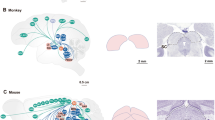Conclusions
-
1.
Afferent cortico-striatal and nigro-striatal connections develop unidirectionally during early postnatal ontogenesis in rabbits.
-
2.
During the functional maturation of the afferent connections of the caudate nucleus running from the cortical zones (motor, anterior and posterior limbic) and substantia nigra, the latent period and duration decline and the amplitude of the evoked potential increases in response to stimulation of the appropriate inputs from the immature (at the age of two to five days) to the definitive levels (by 30 days of age).
-
3.
The sharpest change in the amplitude-temporal parameters of the response of the caudate nucleus, especially the latent period, was noted during the third week of the postnatal life of the rabbit.
-
4.
On the basis of the obtained data, the period of ontogenesis occurring during the third to fourth week of rabbit life is considered as the critical period of development of the sensory mechanisms of the striatum.
Similar content being viewed by others
Literature cited
O. V. Godukhin, “Electrophysiological analysis of interaction of afferent inputs in rat neostriatum,” Neirofiziologiya,11, No. 4, 382 (1979).
V. S. Zelenskaya and G. M. Gruzdev, “Interaction of influence of functionally differing zones of cerebral cortex on caudate-nucleus neurons in the cat,” Neirofiziologiya,13, No. 2, 142 (1981).
G. M. Nikitina, Development of Integral Activity of the Organism during Ontogenesis [in Russian], Meditsina, Moscow (1970).
G. M. Nikitina, A. I. Boravova, O. N. Barsova, and N. L. Pisareva, “Ontogenetic aspects of the study of caudate control of behavior,” in: The Developing Brain (Theses of Reports) [in Russian], Metsniereba, Tbilisi (1984), p. 156.
N. F. Suvorov, “Role of strio-thalamo-cortical system in conditioned reflex activity,” in: The Strio-pallidal System [in Russian], Nauka, Leningrad (1973), p. 3.
N. F. Suvorov, The Striai System and Behavior [in Russian], Nauka, Leningrad (1980).
B. F. Tolkunov, The Striatum and Sensory Specialization of the Neuronal Network [in Russian], Nauka, Leningrad (1978).
E. Fifkova and J. Marshall, “Stereotaxic atlases of the brain of the cat, rabbit, and rat,” in: Electrophysiological Research Methods [Russian translation], Izd. IL, Moscow (1962), p. 384.
A. M. Adinolfi, “The postnatal development of the caudate nucleus: a Golgi and electron microscopic study of kittens,” Brain Res.,133, No. 2, 251 (1977).
A. M. Adinolfi and A. Nieto, “Postnatal development of basal ganglia in kittens. I. Corticostriate and striopallidal projections,” Anat. Rec.,190, No. 2, 319 (1978).
N. A. Buchwald and C. D. Hull, “Some problems associated with interpretation of physiological and behavioral responses to stimulation of caudate and thalamic nuclei,” Brain Res.,6, No. 1, 1 (1967).
N. A. Buchwald, D. D. Price, L. Vernon, and C. D. Hull, “Caudate intracellular response to thalamic and cortical inputs,” Exp. Neurol.,38, 311 (1973).
J. Carman, W. M. Cowan, and T. P. S. Powell, “The organization of corticostriate connections in the rabbit,” Brain,86, No. 3, 525 (1963).
V. B. Domesic, “Projections from the cingulate cortex of the rat,” Brain Res.,12, No. 2, 296 (1969).
J. M. Kemp and T. P. S. Powell, “The synaptic organisation of the caudate nucleus,” Phil. Trans. Roy. Soc., Ser. B,262, No. 845, 403 (1971).
J. M. Kemp and T. P. S. Powell, “The site of termination of afferent fibres in the caudate nucleus,” Phil. Trans. Roy. Soc., Ser. B,262, No. 845, 413 (1971).
T. I. Lidsky, N. A. Buchwald, C. D. Hull, and M. S. Levine, “A neurophysiological analysis of the development of cortico-caudate connections in the cat,” Exp. Neurol.,50, No. 2 283 (1976).
R. Morris, M. S. Levine, and E. Cherubini, “Intracellular analysis of the development of responses of caudate neurons to stimulation of cortex, thalamus and substantia nigra in kittens,” Brain Res.,173, No. 3, 471 (1979).
W. J. H. Nauta, “Some projections of the medial wall of the hemisphere in the rat brain (cortical areas 32 and 25, 24 and 29),” Anat. Rec.,115, No. 2, 352 (1953).
I. I. Showers, “The cingulate gyrus: additional motor area and cortical autonomic regulator,” J. Comp. Neurol.,112, No. 1, 231 (1959).
A. Siegel, R. Troiano, and A. Royce, “Differential projections of the anterior and posterior cingulate gyrus to the thalamus in the cat,” Exp. Neurol.,38, No. 2, 192 (1973).
T. S. Sotnichenco, “Convergence of the descending pathways of motor, visual and limbic cortex in the cat di- and mesencephalon,” Brain Res.,116, No. 3, 401 (1976).
V. M. Tennyson, R. E. Barrett, and G. Cohen, “The developing neostriatum of the rabbit: correlation of fluorescence histochemistry, electron micorscopy, endogenous dopamine levels, and su3f dopamine uptake,” Brain Res.,46, No. 2, 251 (1972).
K. E. Webster, “Cortico-striatal projection in the cat,” J. Anat.,99, No. 2, 329 (1965).
Author information
Authors and Affiliations
Additional information
Translated from Zhurnal Vysshei Nervnoi Deyatel'nosti imeni I. P. Pavlova, Vol. 36, No. 3, pp. 475–481, May–June, 1986.
Rights and permissions
About this article
Cite this article
Nikitina, G.M., Boravova, A.I. & Pisareva, N.L. Development of afferent function of striatum in rabbits during early ontogenesis. Neurosci Behav Physiol 17, 311–316 (1987). https://doi.org/10.1007/BF01183060
Received:
Issue Date:
DOI: https://doi.org/10.1007/BF01183060




